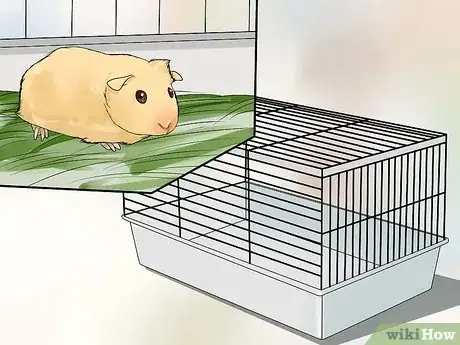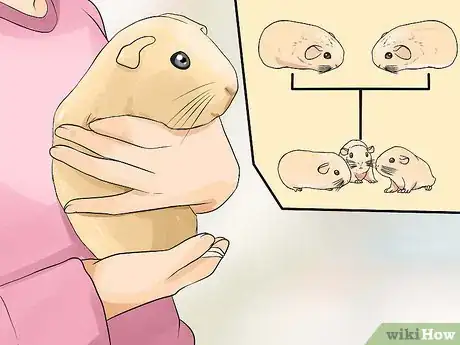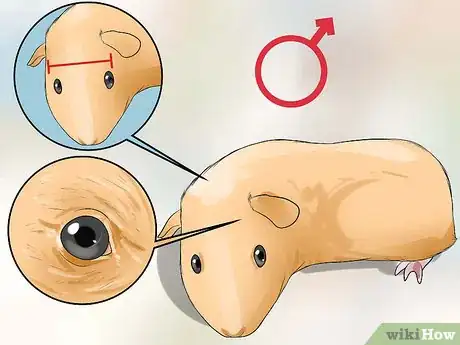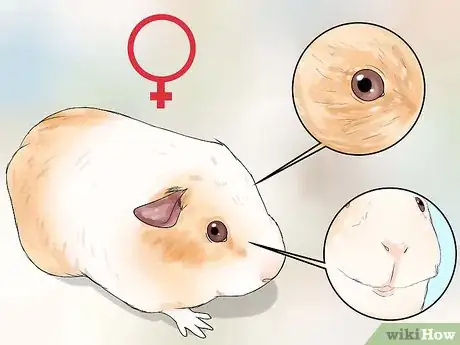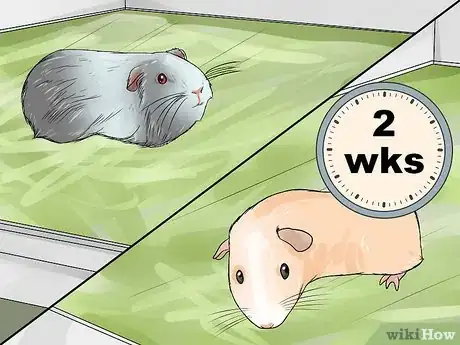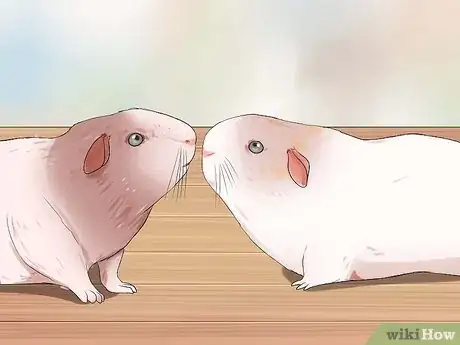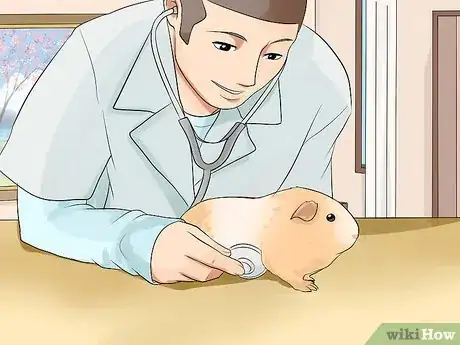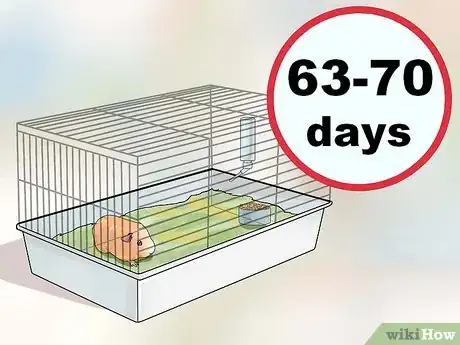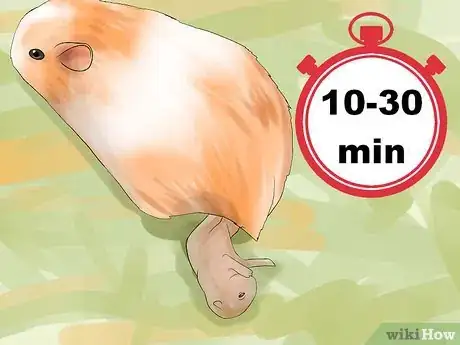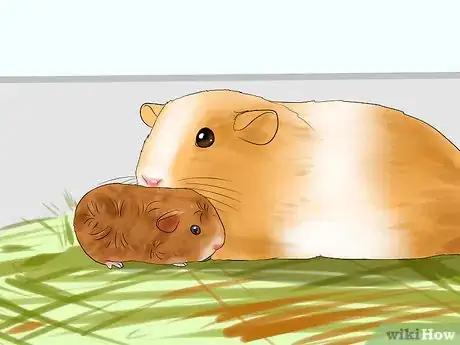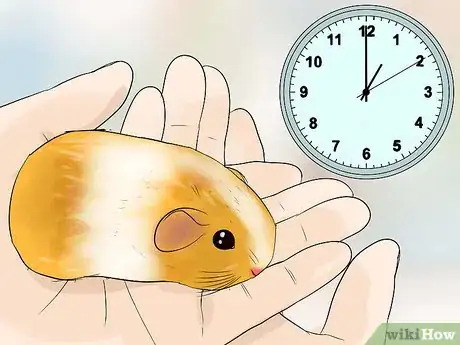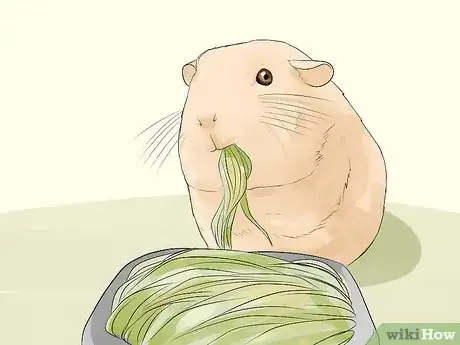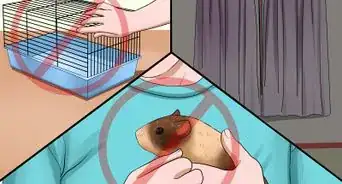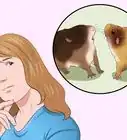This article was co-authored by Pippa Elliott, MRCVS. Dr. Elliott, BVMS, MRCVS is a veterinarian with over 30 years of experience in veterinary surgery and companion animal practice. She graduated from the University of Glasgow in 1987 with a degree in veterinary medicine and surgery. She has worked at the same animal clinic in her hometown for over 20 years.
There are 18 references cited in this article, which can be found at the bottom of the page.
wikiHow marks an article as reader-approved once it receives enough positive feedback. This article received 14 testimonials and 86% of readers who voted found it helpful, earning it our reader-approved status.
This article has been viewed 282,033 times.
If you own Standard Guinea Pigs, which are also called cavies, you may want to breed them as pets or sell them to other guinea pig enthusiasts. Breeding Standard Guinea Pigs is not for the faint of heart because it can be risky and requires a lot of consideration and commitment. For successful breeding, it is essential to thoughtfully pair the right boar and sow and take proper care of them and their litter.
Steps
Getting Started
-
1Be aware of the risks of breeding guinea pigs. Breeding guinea pigs comes with some significant risks including high mortality rate for pregnant animals.[1] Be aware of the risks of breeding guinea pigs and consider if this is the right decision for your animal and for you.
- Never breed guinea pigs for fun. Breeding guinea pigs is risky and can harm or kill your beloved pet.[2]
- Guinea pig sows have a high mortality rate associated with pregnancy ketosis, which is a metabolic problem where the sow slowly poisons herself and dies of blood poisoning. The piglets are also large, which can cause problems when giving birth (but toxaemia is the main cause of death).[3]
- If you are considering breeding your sow, stick to the breeding age suggestions to help minimize the risk of complications.[4]
- If you sow needs a caesarian section because of birth complications, the survival rate is very low.[5]
- Unless you have designated homes for pups or animals you don’t want to keep after breeding, don’t breed them. Many people who say they’ll take pups conveniently disappear once they’re born.[6]
-
2Ensure you have supplies to breed and house pups. If you are planning on breeding guinea pigs, the animal population in your home will likely increase. Ensure that you have sufficient supplies to care for breeding animals and their pups.[7]
- You will need enough cage space to house all of the animals. Keep in mind that you will also have to separate males and females to keep them from breeding.[8]
- The cage space will require proper bedding and hay, so consider purchasing extra and keeping a reserve for when you clean the guinea pigs’ area.[9] Also consider purchasing more accessories such as toys or hiding holes for your guinea pigs to enjoy.
- Make sure you have enough food pellets and water bottles to help keep you guinea pigs healthy.[10]
- Allot enough time to properly clean the guinea pig cages on a daily, weekly, and monthly basis to help keep your pigs healthy.[11]
Advertisement -
3Choose the guinea pigs to breed. You want to find the best quality breeding stock of guinea pigs. Choosing the right guinea pigs can help ensure their health and continuation of quality breeding stock.[12]
- The breeding plan “best to the best” is often employed by professionals when considering mates. This means that only outstanding sows, or female guinea pigs, are bred with outstanding boars, or male guinea pigs.[13]
- Where possible, check the parentage of both guinea pigs. There are several hereditary diseases that could affect the guinea pigs and their pups or cause a so-called “lethal,” or a pup with severe deformities.[14]
- Ensure that the boar and sow are an appropriate age to breed.[15]
- If you are unsure of the sex of your guinea pig, you can check directly above the anus while gently holding the guinea pig on its back. A male will have what appears to be a slit or visible testes. A female will have a skin fold that is in a Y shape above the anus.[16]
-
4Select a boar to mate with a sow. Part of breeding the right pair of guinea pigs is choosing a boar, or male guinea pig, to mate. Selecting the best quality boar can help ensure that a sow bears good quality and healthy pups.[17]
- A good boar will have a broad head and a bold eye.[18]
- The average age for most boars to mate for the first time is 5 months.[19] Guinea pigs are thought to reach sexual maturity at 10 weeks however most reach sexual maturity as young as 4 weeks. Therefore to prevent inbreeding males should be removed from the females at 3 weeks..[20]
-
5Select a sow to mate with a boar. Just as boar selection is important, it is also important to find a good quality sow, or female guinea pig. Choosing the right sow can help ensure the quality and health of her litter.[21]
- The sow should have good head shape, a bold eye, and a good muzzle. [22]
- Guinea pigs are thought to reach sexual maturity at 10 weeks however most reach sexual maturity as young as 4 weeks. Therefore to prevent inbreeding males should be removed from the females at 3 weeks. [23] A sow may be mated at anywhere from 4-7 months for the first time.[24]
- It is important that the sow is under 7 months for a first pregnancy to prevent the conditions symphysis and dystocia[25] .
- Consider selecting a sow that has had time to rest in between litters to help ensure the quality of subsequent litters.[26]
Breeding Tips
-
1Have each guinea pig’s health checked. You cannot introduce a boar and sow unless you are sure they are both healthy. Take each animal to a vet to minimize the risk of either animal being unhealthy.
- If you regularly treat your guinea pigs for mites, this should be done at least 2 weeks before you breed them to prevent the Ivermectin having any effect on the pups.[27]
-
2Quarantine new guinea pigs for two weeks. If you decide to mate your guinea pig with a guinea pig from another home, quarantine the new guinea pig for two weeks. This will help ensure that neither animal is ill or has parasites.[28]
- You can quarantine new guinea pigs simply by keeping their cages in separate rooms. Also make sure to wash your hands whenever you touch animals and their feed or bedding.[29]
- Do not allow the guinea pigs to interact during the quarantine.[30]
- If you are breeding guinea pigs you own, there is no need for quarantine.[31]
-
3Introduce the mating pair. Once you are sure each guinea pig is healthy, you can introduce the pair. It may take a few days for the guinea pigs to get used to one another.
- Keep the pair in the sow's normal cage to reduce stress to her and help increase the chance of pregnancy. If she is not ready to breed, she may reject the male by spraying him or showing her teeth.[32]
- Never allow more than one boar contact with the sow as this can lead to serious fights between the males.[33]
- If you own multiple sows that usually live together, remove the sows you are not breeding to a different cage to prevent unnecessary stress. Maintain the companionship between sows by allowing them 'floor time' together while keeping the breeding pair together the majority of the time.
-
4Don’t disturb breeding pair during the heat cycle. A sow’s heat cycle can last from 15 to 17 days. The breeding pair should be kept together the entire cycle to increase the chance of pregnancy.
- The pair may try to mate throughout this period, but the sow can only get pregnant during a small 24 – 48 hour window per cycle.[34] .
- Check the breeding couple often enough to help ensure their health and happiness and reassure the guinea pigs that you are caring for them.
Pregnancy and Birth
-
1Check if the sow is pregnant. After at least 18 days, check if the sow is pregnant. You can do this yourself - see How to Tell if Your Guinea Pig Is Pregnant - but only a vet will be able to say for sure.
- A pregnant female may exhibits several symptoms of pregnancy including distended abdomen and increased food and water consumption.[35] A sow may eat 2-3 times her normal amount when pregnant.[36]
- A vet may also determine an estimated delivery date.
- It may take several heat cycles for the sow to become pregnant. Be patient so that you do not stress your guinea pigs.
-
2Care for the sow during the gestation period. Once you’re sow becomes pregnant, the gestation period will 63-70 days.[37] During this time it is important to prevent stress as much as possible.
- Do not make any changes to the sow’s cage and reduce exposure to anything that may cause stress, such as loud noises.[38]
- Handle the sow minimally during the pregnancy and not at all during the last two weeks. You can coax her on to a towel or box for the delivery.[39]
- You can leave the boar in the cage with the sow to comfort her.[40]
- It’s advisable to remove other guinea pigs from the sow’s space and allow her to litter alone.[41]
-
3Increase the sow’s diet. The amount of food and water a sow consumes will increase during pregnancy. Give her more food to help ensure she gets much needed nutrients to support the developing pups.
- Increase the amount of fresh vegetables on offer to 1½ to 2 cups per day.
-
4Check for health issues during pregnancy. Pregnancy is very risk for sows because pups are large. Check the sow thoroughly daily by looking for any signs of illness and weighing the sow.
- The signs of illness may include crusty eyes, nose, or ears; and a thinning or patchy coat.[42]
- The sow should gradually put on weight, though how much depends on the individual and size of the litter.
- Check she is eating. An early warning sign of pregnancy toxaemia is lack of appetite. Any pregnant sow that doesn't eat for more than 12 hours should see a veterinarian.
- If you notice any problems with your guinea pig, including lack of movement of her unborn pups, consult a vet.
-
5Get ready for the birth of the pups. You should be prepared for your sow to give birth at around nine weeks. Making sure you’re prepared for the birth with medical supplies can help you handle any complications that may arise.
- Guinea pigs don’t show any outward signs of impending birth and don’t make any specific preparations for labor so it may be hard to tell exactly when the sow will give birth.[43]
- You may notice a slight widening of the pelvic bones in the sow right before she gives birth.[44]
- Stock up on a syringe, which you may need to clean out a newborn pups mouth.[45]
- It is a good idea to alert a vet when the sow reaches nine weeks so they are aware that they may need to intervene and can be on hand to attend to the sow immediately if a complication does arise.
-
6Expect short labor if there are no complications. It takes guinea pigs 10-30 minutes to give birth if a sow has no complications. If the labor takes longer than an hour, call your vet or take the sow for medical treatment.[46]
- Do not crowd the female while she is laboring. Have only one person with her to oversee the birth and do not touch her.[47]
- A sow should give birth every 5-10 minutes.[48] A sow will usually have between 1-5 pups.[49]
- The sow will give birth by sitting up and hunching over or by squatting.[50]
- Get your guinea pig to a doctor if the labor becomes complicated. For example, if it takes longer than one hour, there more than 15 minutes between pups, if she exhibits excessive bleeding, or making extreme stress calls.[51]
Handling Pups
-
1Allow the sow to clean her pups. Once your sow has given birth, let her clean the pups on her own. This can help minimize the risk of transmitting bacteria to the new pups or the mother rejecting them. It is also important that the mother massages the area around the lungs to help the pups to breathe. If the pup is removed from being massaged, it might die.[52]
- The mother or other cage mates will eat the placenta and membranes.[53]
-
2Expect alert and fully functional pups. When pups are born, they should appear fully functional and like miniature adults.[54] In the case that a pup doesn’t appear normal, consult your vet.[55]
- Newborn pups should have hair, wide open eyes, a full set of teeth and be able to run around like other guinea pigs.[56]
- The pups do not require a heat lamp or heating pad as long as the room is warm. They should be kept at the same comfortable temperature as the parents.[57]
- The mother may reject one of the pups, often the runt of the litter. There may be nothing wrong with this pup however, so hand-feed and continue to place with the mother. Try some one-on-one between the pup and mother.[58]
-
3Wait a full day before handling the mother and pups. Guinea pigs are not especially protective or proactive with their young, but give the mother and pups a full day after birth before you handle them. After this, you can handle them as much as you like.
- It is encouraged to handle the pups to help socialize them.[59]
-
4Continue to provide a rich diet for the mother. Continue to provide alfalfa hay and extra food pellets while the mother nurses. This will help ensure the sow stays healthy as she feeds her pups and minimize the risk that her milk quality is poor.[60]
-
5Examine the pups and the mother. One day following the birth and occasionally thereafter, examine the mother and pups. This will help you identify “lethals” and any other conditions. Consult a vet if you notice any medical issues or have questions.
Expert Q&A
Did you know you can get expert answers for this article?
Unlock expert answers by supporting wikiHow
-
QuestionMy boar is two, but my sow is 6 months. Can I still breed them?
 Pippa Elliott, MRCVSDr. Elliott, BVMS, MRCVS is a veterinarian with over 30 years of experience in veterinary surgery and companion animal practice. She graduated from the University of Glasgow in 1987 with a degree in veterinary medicine and surgery. She has worked at the same animal clinic in her hometown for over 20 years.
Pippa Elliott, MRCVSDr. Elliott, BVMS, MRCVS is a veterinarian with over 30 years of experience in veterinary surgery and companion animal practice. She graduated from the University of Glasgow in 1987 with a degree in veterinary medicine and surgery. She has worked at the same animal clinic in her hometown for over 20 years.
Veterinarian
-
QuestionCan a two year old sow get pregnant or is this too risky?
 Pippa Elliott, MRCVSDr. Elliott, BVMS, MRCVS is a veterinarian with over 30 years of experience in veterinary surgery and companion animal practice. She graduated from the University of Glasgow in 1987 with a degree in veterinary medicine and surgery. She has worked at the same animal clinic in her hometown for over 20 years.
Pippa Elliott, MRCVSDr. Elliott, BVMS, MRCVS is a veterinarian with over 30 years of experience in veterinary surgery and companion animal practice. She graduated from the University of Glasgow in 1987 with a degree in veterinary medicine and surgery. She has worked at the same animal clinic in her hometown for over 20 years.
Veterinarian
Warnings
- The sow will come into heat as soon as she gives birth. If the boar is still in the cage, he can impregnate her. It is best to remove the boar to prevent another immediate pregnancy. This will allow the sow to recover.[65]⧼thumbs_response⧽
Things You'll Need
- At least two cages.
- Extra supplies including food and bedding.
- Two healthy guinea pigs of the opposite sex.
- Records of the boar and sows immediate family.
References
- ↑ http://www.guinealynx.info/breeding.html
- ↑ http://www.guinealynx.info/breeding.html
- ↑ http://www.guinealynx.info/breeding.html
- ↑ http://www.guinealynx.info/breeding.html
- ↑ http://www.guinealynx.info/breeding.html
- ↑ http://www.guinealynx.info/breeding.html
- ↑ http://www.cavyspirit.com/breeding.htm#jacba
- ↑ http://www.cavyspirit.com/breeding.htm#jacba
- ↑ http://www.cavyspirit.com/breeding.htm#jacba
- ↑ http://www.cavyspirit.com/breeding.htm#jacba
- ↑ http://www.cavyspirit.com/breeding.htm#jacba
- ↑ http://www.britishcavycouncil.org.uk/Resources/Selfs-top%20breeders-BCC.pdf
- ↑ http://www.britishcavycouncil.org.uk/Resources/Selfs-top%20breeders-BCC.pdf
- ↑ http://www.cavyspirit.com/breeding.htm#jacba
- ↑ http://www.britishcavycouncil.org.uk/Resources/Selfs-top%20breeders-BCC.pdf
- ↑ http://petguineapigcare.com/breeding-babies/
- ↑ http://www.britishcavycouncil.org.uk/Resources/Selfs-top%20breeders-BCC.pdf
- ↑ http://www.britishcavycouncil.org.uk/Resources/Selfs-top%20breeders-BCC.pdf
- ↑ http://www.britishcavycouncil.org.uk/Resources/Selfs-top%20breeders-BCC.pdf
- ↑ http://petguineapigcare.com/breeding-babies/
- ↑ http://www.britishcavycouncil.org.uk/Resources/Selfs-top%20breeders-BCC.pdf
- ↑ http://www.britishcavycouncil.org.uk/Resources/Selfs-top%20breeders-BCC.pdf
- ↑ http://petguineapigcare.com/breeding-babies/
- ↑ http://www.britishcavycouncil.org.uk/Resources/Selfs-top%20breeders-BCC.pdf
- ↑ http://www.petmd.com/exotic/conditions/reproductive/c_ex_gp_dystocia
- ↑ http://www.britishcavycouncil.org.uk/Resources/Selfs-top%20breeders-BCC.pdf
- ↑ http://www.guinealynx.info/ivermectin.html
- ↑ http://www.guinealynx.info/quarantine.html
- ↑ http://www.guinealynx.info/quarantine.html
- ↑ http://www.guinealynx.info/quarantine.html
- ↑ http://www.guinealynx.info/quarantine.html
- ↑ reeding-babies/
- ↑ http://www.britishcavycouncil.org.uk/Resources/Selfs-top%20breeders-BCC.pdf
- ↑ http://www.guinealynx.info/reproduction.html
- ↑ http://petguineapigcare.com/breeding-babies/
- ↑ http://petguineapigcare.com/breeding-babies/
- ↑ http://petguineapigcare.com/breeding-babies/
- ↑ http://petguineapigcare.com/breeding-babies/
- ↑ http://petguineapigcare.com/breeding-babies/
- ↑ http://www.guinealynx.info/breeding.html
- ↑ http://www.britishcavycouncil.org.uk/Resources/Selfs-top%20breeders-BCC.pdf
- ↑ http://www.merckvetmanual.com/pethealth/exotic_pets/guinea_pigs/disorders_and_diseases_of_guinea_pigs.html
- ↑ http://petguineapigcare.com/breeding-babies/
- ↑ http://emmasguineapigs.blogspot.de/p/breeding-info.html
- ↑ http://emmasguineapigs.blogspot.de/p/breeding-info.html
- ↑ http://petguineapigcare.com/breeding-babies/
- ↑ http://www.britishcavycouncil.org.uk/Resources/Selfs-top%20breeders-BCC.pdf
- ↑ http://petguineapigcare.com/breeding-babies/
- ↑ http://www.britishcavycouncil.org.uk/Resources/Selfs-top%20breeders-BCC.pdf
- ↑ http://petguineapigcare.com/breeding-babies/
- ↑ http://www.guinealynx.info/labor.html
- ↑ http://petguineapigcare.com/breeding-babies/
- ↑ http://petguineapigcare.com/breeding-babies/
- ↑ http://www.britishcavycouncil.org.uk/Resources/Selfs-top%20breeders-BCC.pdf
- ↑ http://petguineapigcare.com/breeding-babies/
- ↑ http://petguineapigcare.com/breeding-babies/
- ↑ http://petguineapigcare.com/breeding-babies/
- ↑ http://petguineapigcare.com/breeding-babies/
- ↑ http://petguineapigcare.com/breeding-babies/
- ↑ http://www.guinealynx.info/breeding.html
- ↑ http://www.guinealynx.info/breeding.html
- ↑ http://www.guinealynx.info/breeding.html
- ↑ http://www.guineapigcorner.com/size
- ↑ http://www.guinealynx.info/breeding.html
- ↑ http://www.britishcavycouncil.org.uk/Resources/Selfs-top%20breeders-BCC.pdf
About This Article
To breed standard guinea pigs, choose a male and female and have them examined by a vet to confirm that they're healthy and ready for breeding. Next, introduce the pair to each other in the female guinea pig's cage when she's close to her heat cycle. Allow them to live together in the cage without other guinea pigs around and let nature take its course. Be sure to keep them together during the entire heat cycle to increase the chance of pregnancy. For tips on caring for a pregnant guinea pig, read on!

